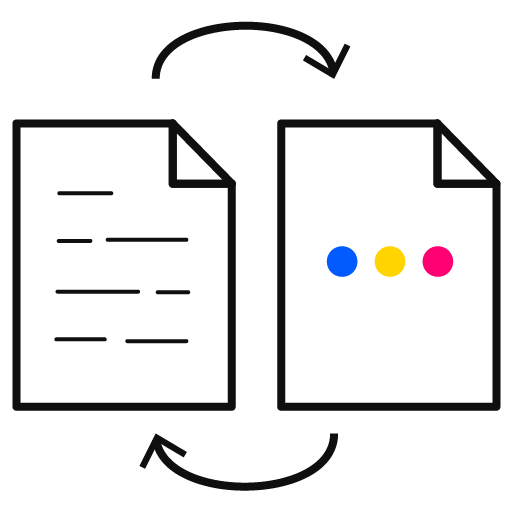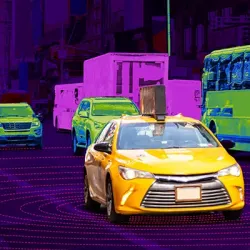Industry Knowledge
Generative AI 101: A Comprehensive Guide for Businesses
GenAI is an AI technology that creates unique content by learning from data, unlocking creativity and efficiency through ML models like GANs.
- What is Generative AI?
- Types of Generative AI
- How Does Generative AI Work?
- How to Create a Generative AI Model
- How to Train a Generative AI
- What can Generative AI Do?
- Generative AI for Business
- Benefits of Generative AI
- Examples of Generative AI Tools
- Limitations of Generative AI
- Challenges of Generative AI
- What Does the Future of Generative AI Look Like?
- Generate More Possibilities With Us
Generative AI is blurring the lines between human creativity and machine capability. It challenges traditional boundaries of technology and proves that the distinctions between humans and machines are becoming less defined. Experts predict that GenAI will significantly impact productivity, adding a whopping $4.4 trillion to the global economy.[1] In this article, we’ll explore the different types of GenAI, examine its applications across various industries, and learn how it can impact your business.
What is Generative AI?
GenAI is an advanced technology that uses complex algorithms to analyze large data sets, allowing it to generate outputs that mimic the style and characteristics of the input, yet remain unique.
This technology employs intricate algorithms and neural network architectures, often powered by large language models (LLMs). Its main objective is to process and produce text, images, or other types of content. In a professional setting, Generative AI becomes a valuable asset in enhancing operational processes, particularly in content generation and customer service, making it an indispensable tool for businesses navigating the demands of a dynamic marketplace.
Building on the understanding of GenAI as a tool that produces novel content, it's important to know how it differs from other AI technologies:
- AI vs. Generative AI: Traditional AI relies on strict rules to perform fixed tasks with precision, while Generative AI, through machine learning, discovers patterns in data to create original content, pushing the bounds of AI innovation.
- Generative AI vs. Predictive AI: Predictive AI forecasts future events using historical data, while GenAI creates new, original content using learned patterns.
- Generative AI vs. Conversational AI: Conversational AI is a branch of AI designed to mimic human conversation. However, GenAI has a broader range of capabilities, including generating creative content such as visual art and design innovations.
In this way, GenAI represents a leap from traditional and conversational AI's analytical and interactive facets towards an AI that can innovate and generate.
Types of Generative AI
Exploring the technology further, we encounter a variety of innovative models that shape its ability to create. Generative AI has various types, each with its specialized role:
- Variational Autoencoders (VAEs): VAEs are adept at transforming and compressing data, creating new instances that resemble the original input but with novel variations. They offer a way to produce new content by understanding and traversing the complex landscape of data points.
- Generative Adversarial Networks (GANs) and Conditional GANs (cGANs): GANs have brought a competitive edge to GenAI. They consist of two neural networks—the generator and discriminator—that pit against each other. Adding to this are cGANs, which condition the generation process on additional information, allowing for more specific and controlled outputs. This rivalry pushes the generator to produce outputs that resemble real-life data, leading to highly realistic synthetic images and media.
- Diffusion Models: Diffusion models learn to create detailed images by reducing noise from random data, representing a new frontier in high-fidelity visual content generation.
- Transformers: Originally used in language processing, they have expanded their capabilities to excel in tasks that require a deep understanding of context and the ability to generate coherent text. Their adaptability also makes them suitable for image generation, highlighting the potential of Generative AI in various domains.
- Neural Radiance Fields (NeRFs): NeRFs are a cutting-edge technology changing the game in 3D scene reconstruction. They can now derive spatial and lighting information from 2D images to produce stunning and realistic 3D models. They open up virtual and augmented reality possibilities, creating immersive and accurate visual experiences.
How Does Generative AI Work?
Generative AI works by analyzing patterns within large volumes of data and using this understanding to produce new data that is similar in nature. It learns from examples—whether they're pictures, sounds, or text—by recognizing the complex structures embedded within them. By doing so, GenAI can create content with the same style and essence as the original data but is unique.
This process of learning and creating is typically achieved through sophisticated algorithms, neural network architectures, and LLMs that excel in processing and generating human-like text. These models mimic some aspects of human brain processing, allowing the technology to perform tasks that require a deep understanding of language, such as translating languages, answering questions, and creating content that feels authentic. This technology does not only replicate the input data; it imagines variations, fills in gaps, or even generates entirely new concepts. GenAI combines the precision of a computer with a touch of creativity traditionally attributed to humans.
How to Create a Generative AI Model

Creating a Generative AI model is an intricate process that begins with selecting the right type of model for the task at hand. For instance, if the goal is to generate realistic images, a GAN (Generative Adversarial Network) is a suitable option, while if the objective is to produce text, a transformer model could be the right choice. Once you've chosen your model, the next step is to feed it a large volume of relevant data. This data becomes the foundational knowledge that the AI will use to learn patterns and understand the characteristics of what it’s meant to generate.
The model then enters a training phase where it assimilates the data and improves its ability to produce new content. This step involves repeatedly running computations on the provided data, refining its internal parameters until it can generate coherent outputs that closely resemble the input data. During this phase, the model often goes through a cycle of trial and error, gradually improving with each iteration.
The training process continues until the model reaches a satisfactory level of performance, as determined by its ability to create diverse and representative outputs of the training data. After fully training the model, it can generate new content, becoming a resourceful asset for creative and professional tasks.
How to Train a Generative AI
It is important to train your AI model after understanding how GenAI works and putting it into practice. This step involves teaching the AI through examples, eventually enabling it to generate its own outputs. By following a structured approach to model training, you can guide the AI through a learning journey that will help it to produce convincing and creative content. Here is a step-by-step roadmap that you can follow to make that happen:
-
Gather Data:Collect a large and diverse dataset that closely aligns with what you want your AI model to generate. The quality and variety of your data significantly influence the model's ability to learn and create.
-
Preprocess Data:Prepare the dataset for training by cleaning and organizing it. This includes normalizing values, resizing images, or tokenizing text. Consistent and well-processed data helps improve training efficiency.
-
Choose a Model Architecture:Pick an appropriate model type for your project. Architectures like GANs, VAEs, or transformers serve different purposes and data types.
-
Train the Model:Instruct your model to identify and imitate data patterns by processing the information repeatedly fine-tuning its parameters to enhance accuracy and reduce errors.
-
Evaluate and Refine:Regularly evaluate your model's performance using a separate validation dataset. Adjust your model based on these evaluations to fine-tune its generative capabilities until it produces satisfactory results.
-
Iterate as Necessary:Training a Generative AI model is an iterative process. You may need to revisit earlier steps, tweak your model, or even retrain from scratch with a revised dataset or architecture to achieve the desired outcome.
Training a GenAI model requires time, patience, and attention to detail. The model's ability to create compelling content will improve with meticulous training and refinement.
What can Generative AI Do?
GenAI is transforming the way we create and produce content. With its incredible flexibility, Generative AI is being integrated into numerous industries, enhancing and sometimes even automating the creative process. It can be used for designing stunning graphics, composing music, generating engaging stories, and producing realistic speech, among many other applications. The possibilities of this technology are endless and can profoundly impact many industries:
- In image and video generation, GenAI is revolutionizing how we think about visuals. Artists and designers can pair their creativity with AI to render new pieces of art or design prototypes. At the same time, filmmakers can utilize these models for special effects or to fill in backgrounds, reducing the need for extensive on-site shoots. In fashion and interior design, AI-generated images provide a way to visualize products or spaces before they are physically produced, offering a sustainable and cost-effective alternative.
- With audio generation, musicians and sound engineers have a new tool. GenAI can compose music or create sound effects, enriching the auditory experience in games, movies, and virtual reality settings. It can simulate instruments and voices, providing a broader palette of sounds that might be difficult or impossible to record in a studio.
- Text generation finds Generative AI spinning narratives, writing articles, composing poetry, and coding. This capability is being utilized by marketers to create ad copy, publishers to generate content, and scriptwriters to brainstorm dialogues. Researchers and academics also use it to draft papers and abstracts, making writing faster.
- Finally, GenAI exhibits exceptional proficiency in the field of speech synthesis. It can convert text to speech, almost indistinguishable from a human voice. This has significant implications for assistive technologies, enabling more natural-sounding voice assistants and helping individuals with speech impairments communicate more effectively.
Generative AI for Business
As we explore the tangible applications of Generative AI, it becomes clear that its impact stretches far beyond creative arts and consumer products. For businesses, this technology is a powerful catalyst for innovation and efficiency. Here's how businesses in different industries utilize the tool to drive growth and transformation:
- In healthcare, GenAI aids in developing new drugs by predicting molecular structures and simulating their effects, drastically reducing research times. Additionally, it helps in medical imaging by enhancing the quality of scans, enabling earlier and more accurate diagnoses without the need for invasive procedures.

- The transportation industry, including the development of autonomous vehicles, is leveraging this technology to improve vehicle design and traffic management systems. AI-generated models can simulate countless scenarios, testing the efficiency and safety of vehicle components, including those crucial for the functioning of self-driving cars. Similarly, it can model traffic flow to optimize routes and reduce congestion, contributing to smarter city planning and integrating autonomous vehicle networks.

- Within retail and e-Commerce, GenAI enriches the shopping experience by personalizing product recommendations and creating virtual try-ons. It generates realistic images and product descriptions, enabling businesses to adapt their offerings to changing market demands and customer preferences. This not only bolsters customer satisfaction but also drives sales.

SOLUTIONS BRIEF
Data Labeling for Retail & ECommerce Industry Solutions Brief
Download the Solutions Brief- Lastly, in FinTech, Generative AI fuels innovation by detecting fraudulent activities and managing risks through advanced predictive models. It also automates financial reporting and document generation, thereby increasing efficiency and accuracy.

Benefits of Generative AI
GenAI offers numerous advantages to businesses, enabling them to enhance performance and innovate. As the digital landscape evolves rapidly, these benefits become increasingly important in helping enterprises stay competitive and succeed.

Increased Efficiency:
Sophisticated algorithms have significantly accelerated the design and development process across various industries. They quickly produce prototypes, marketing content, and code snippets, which reduces the creation cycle time. This is essential for quickly keeping up with the evolving market trends and launching new products.

Cost Savings:
Understanding your vendors' financial soundness and stability is important. Do they have a long-standing presence in the market? Find out if they have a good business model and if they have served companies similar to yours. Instability in your vendor can hurt your business.

Enhanced Personalization:
New technology enables organizations to provide personalized experiences to their customers without a significant increase in cost. This includes customized marketing, personalized product recommendations, and adaptable customer service. By enhancing customer satisfaction, companies can foster brand loyalty and gain a competitive advantage in the market.
Examples of Generative AI Tools
Open AI’s GPT is a powerful text generation tool making significant strides in the Generative AI space. It has become a preferred choice for tasks ranging from composing emails to generating creative fiction. This is due to its ability to understand and imitate human language accurately. Dall-E is also a pioneer in the field of Generative AI by translating text prompts into vibrant images. It helps creatives and businesses visualize concepts that vary from the mundane to the fantastical.
AssistAI, TaskUs’ powerful customer service application, enhances customer service efficiency. Natural language processing (NLP) and automation seamlessly integrate into service workflows, resulting in faster service, fewer errors, and improved customer response quality. With a focus on practicality, AssistAI is a specialized tool that enhances the customer service experience, establishing TaskUs as a leading provider of innovative business support solutions.
Limitations of Generative AI
Although revolutionary, GenAI has limitations that shape future improvements.

Accuracy and Reliability:
The content generated by AI may not always be reliable, as it relies on the data it was trained with. If the data contains biases or errors, the AI's output will likely reflect them.

Context and Common Sense:
AI systems often struggle to understand the nuances of human communication, leading to content that may miss the mark.

Privacy and Security:
Personalizing experiences through AI requires processing large amounts of personal data, necessitating robust measures to ensure ethical and secure use.
By understanding and addressing these challenges, businesses can strategically integrate Generative AI into their operations, ensuring it complements human expertise.
Challenges of Generative AI
Although we have previously discussed the tool's limitations, including issues with accuracy, context, and data security, it is equally crucial to consider the range of practical challenges that businesses may face when implementing this technology. Successfully navigating these challenges is essential to realize its potential while mitigating any potential drawbacks fully:

GenAI Hallucinations:
Sometimes, GenAI produces strange or completely wrong outputs, called 'hallucinations.' This can happen for various reasons, including data anomalies or overfitting of the model. To prevent GenAI hallucinations, monitoring and refining the AI's output continuously is important. This can be achieved by combining automated checks with human verification to ensure reliability.

Data Quality and Bias:
The quality of the data used to train Generative AI models directly impacts their performance. It is important to source large, unbiased, and high-quality datasets to avoid continuing existing biases and ensure outputs are accurate and fair. Diligent data curation and regular assessments of the AI’s decision-making criteria are necessary to identify and address potential biases.

Ethical Use and Misuse:
As GenAI becomes more advanced, it is becoming increasingly difficult to distinguish between content created by humans and that created by AI. This raises ethical questions about the creation of deepfakes and the spread of false information. To ensure that AI is used ethically, it is crucial to establish clear guidelines and assign responsibility for any misuse of these powerful tools. This will help maintain AI applications' integrity and trustworthiness in society.
What Does the Future of Generative AI Look Like?
The emerging technology is on a path of rapid advancement and is poised to unfold new chapters in innovation. Soon, we can expect to see a significant shift towards refining these systems' ethical use and governance, ensuring transparency and fairness. As AI evolves to understand user preferences more precisely, we can expect personalization to reach new heights, creating highly individualized content and experiences.
Furthermore, AI will not be limited to automation but will emerge as a creative partner, enhancing human potential and facilitating collaboration across diverse sectors. With these advancements, the technology will become more user-friendly and widely available, making it accessible to a broader audience. These developments indicate an era of more nuanced, inventive, and ethically responsible generative AI applications that will integrate seamlessly into the fabric of our digital lives.
Generate More Possibilities With Us
Choosing the right partner is crucial when leveraging generative AI solutions to grow your business. TaskUs, with over a decade of experience, collaborates with the best in AI to create smart systems that streamline your operations and enhance customer interactions. From collecting detailed data and creating customized datasets to training models and ensuring their accuracy, TaskUs covers all aspects.
Partnering with a trusted expert in AI solutions like TaskUs gives your business the edge in a competitive digital world, enabling you to scale up, innovate, and connect with customers like never before.
References
We exist to empower people to deliver Ridiculously Good innovation to the world’s best companies.
Useful Links












